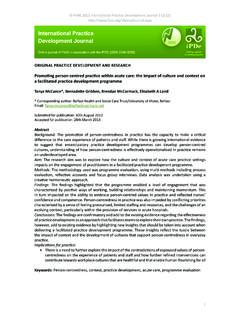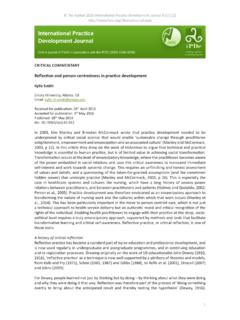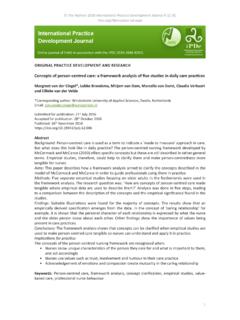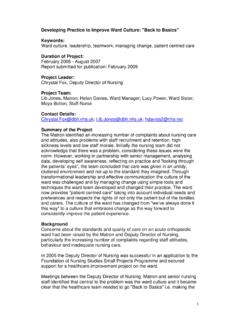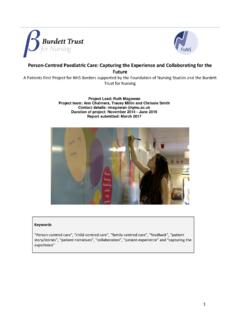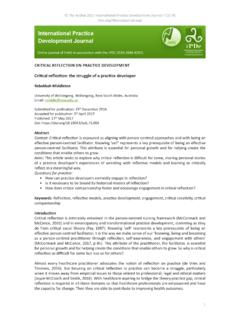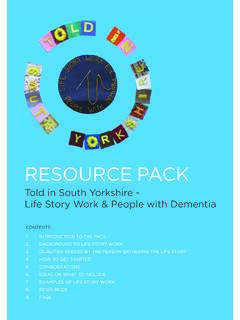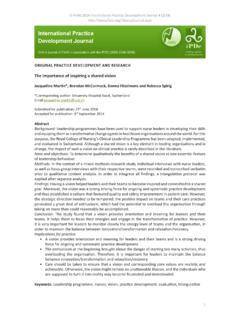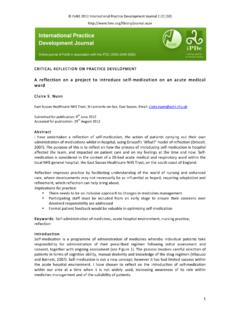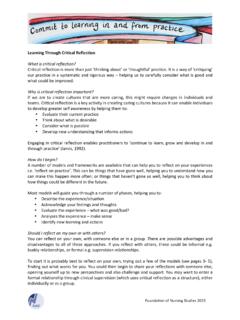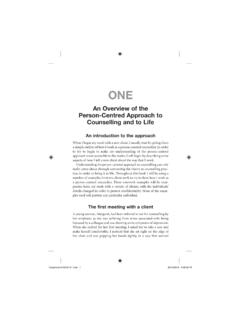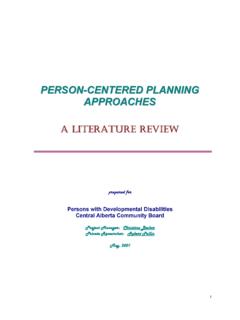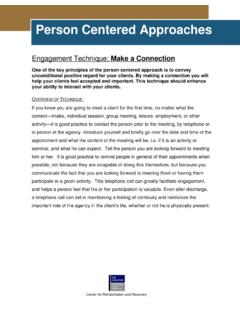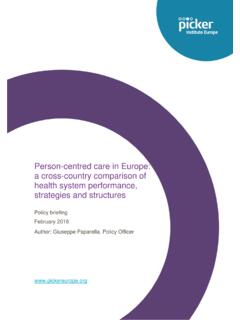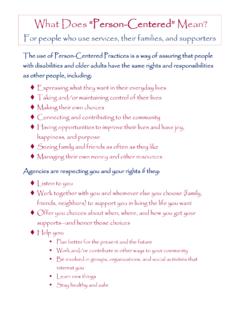Transcription of Person-centredness – the ‘state’ of the art - FoNS
1 FoNS 2015 International Practice Development Journal 5 (Suppl) [1] the state of the artBrendan McCormack*, Marit Borg, Shaun Cardiff, Jan Dewing, Gaby Jacobs, Nadine Janes, Bengt Karlsson, Tanya McCance, Tone Elin Mekki, Davina Porock, Famke van Lieshout and Val Wilson*Corresponding author: Queen Margaret University, Edinburgh, ScotlandEmail: for publication: 28th April 2015 Accepted for publication: 27th May 2015 AbstractBackground: Person- centred practice is now firmly embedded in the nursing and healthcare discourse. While there is a growing body of development and research activity in the field, there is increased recognition of the need for further advances in the body of existing knowledge.
2 This is reflected in the different approaches to Person-centredness being adopted by healthcare systems internationally. Aims: To provide an overview of Person-centredness and ways in which person- centred practice has been adopted in healthcare systems : A summary review of the evidence underpinning the concepts and theory of Person-centredness , incorporating an overview of national strategic frameworks that influence the development of person- centred practice in different : While there have been considerable advances in the development of Person-centredness , there is a lot of work to be done in the adoption of more consistent approaches to its development and evaluation.
3 In particular, a shared discourse and measurement tools are needed. Internationally, Person-centredness is gaining momentum and many countries have strategic frameworks in place to direct its development and : Significant developments in the theory and practice of Person-centredness in nursing and healthcare have taken place. However, as evidenced by the accounts of in-country developments, internationally there is a need to develop more strategic multiprofessional approaches to the development/implementation and evaluation of person- centred practices . Implications for practice: National developments in person- centred healthcare need to reflect the diversity of strategicapproaches internationally While a common language of Person-centredness is emerging, there is a need for clarity overhow this is operationalised in everyday practice situations Keywords: Person-centredness , strategy, international, practice developmentIntroductionThis opening paper is divided into two sections.
4 In section one we present an overview of the concept of Person-centredness and a critique of the way this concept has now become a global phenomenon. We explore how it has been translated into national policy and strategy in a number of countries where we work. Because this is the opening paper of this special issue of the International Practice Development Journal, we describe different components of Person-centredness and the person- centred FoNS 2015 International Practice Development Journal 5 (Suppl) [1] framework of McCormack and McCance (2010). That work continues to be regularly cited in the nursing and healthcare literature as a framework that guides the development and practice of Person-centredness in a variety of healthcare contexts and in many of the projects reported in this special issue.
5 While the framework was originally developed from a nursing perspective, it has been applied in a variety of multidisciplinary contexts. In the second part of the paper, we go on to describe how Person-centredness is strategically positioned in the countries in which the authors of this paper work. This overview of Person-centredness in these countries will serve as an illustration of advances in this area of work and will also strategically position the papers that follow in this special an overview of the conceptThe use of the terms Person-centredness and person- centred care has become increasingly common in health and social care services at a global level.
6 A cynic might argue that the term is being used as a catch-all for anything to do with high-quality health and social care but we would contend that it is representative of something more significant than this, namely, a movement that has an explicit focus on humanising health services and ensuring the patient/client is at the centre of care delivery. In this context, the body of evidence supporting the processes and outcomes associated with Person-centredness in health and social care is constantly growing and becoming increasingly diverse. Published evidence so far has clarified the meaning of the terms personhood and Person-centredness (Dewing, 2004; Slater, 2006; Edvardsson et al.)
7 , 2010), offered insights into the cultural and contextual challenges associated with implementing a person- centred approach (McCormack et al., 2008; McCormack and McCance, 2010; McMillan et al., 2010; McCance et al., 2013; Yalden et al., 2013), and monitored the development of frameworks such as the authentic consciousness framework (McCormack, 2003), the senses framework (Nolan et al., 2004) and the person- centred nursing framework (McCormack and McCance, 2006; 2010) alongside the application and testing of these frameworks in practice (Ryan et al., 2008; McCormack et al., 2010a; 2010b; McCance et al., 2010; McCormack et al.
8 , 2011). In addition, much more emphasis has been placed on outcome evaluation and the development of tools to evaluate the relationships between person- centred processes and outcomes (Slater et al., 2009; McCormack et al., 2010b; Smith et al., 2010; Slater et al., 2015). There is however, still much to be achieved in furthering outcome evaluation and this need was highlighted by the Health Foundation (de Silva, 2014) when the existence of 176 validated tools for evaluating person- centred care were reported, few of which were direct measures and all of which were proxies for Person-centredness . Alongside these advances in the research and scholarly literature, there has been a proliferation of policy- and strategy-focused publications supporting the need for and development of person- centred cultures in healthcare.
9 While these will be referred to in the second part of this paper, the Health Foundation has been instrumental in influencing many of these strategies and for ensuring that, at least at the level of health systems, people are at the centre of care: We want a more person- centred healthcare system, where people are supported to make informed decisions about and to successfully manage their own health and care, and choose when to invite others to act on their We want healthcare services to understand and deliver care responsive to people s individual abilities, preferences, lifestyles and goals (Health Foundation, 2015a).The foundation has produced a range of resources to enable an increased understanding of person- centred care and to support its development in organisations (Health Foundation, 2015b).
10 However, its work on Person-centredness continues to focus mainly on care and less on how organisations create person- centred cultures. The World Health Organization has also promoted a person- centred approach, with a global goal of humanising healthcare by ensuring that it is rooted in universal principles of human rights and dignity, non-discrimination, participation and empowerment, access and equity, and a partnership of equals: FoNS 2015 International Practice Development Journal 5 (Suppl) [1] The overall vision for people- centred health care is one in which individuals, families and communities are served by and are able to participate in trusted health systems that respond to their needs in humane and holistic (World Health Organization, 2007, p 7).
